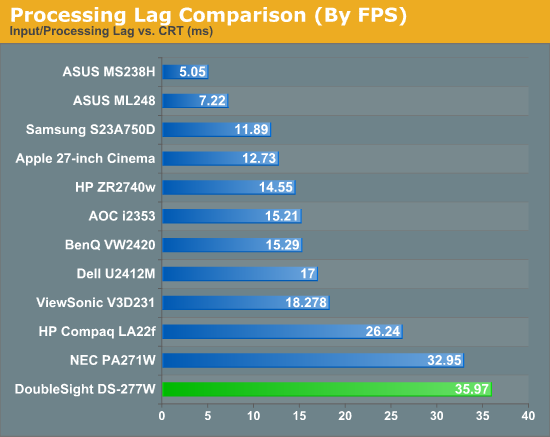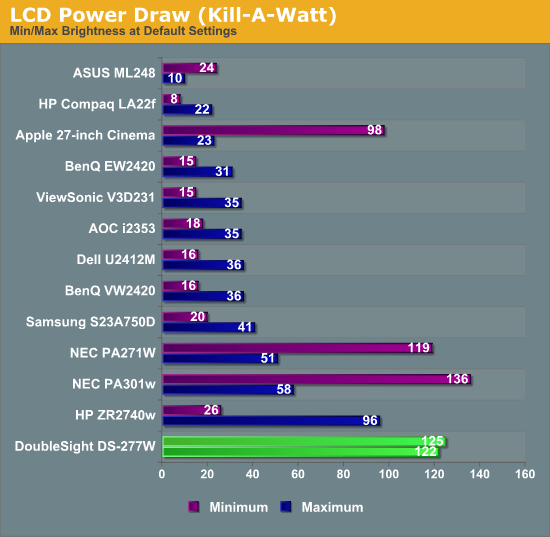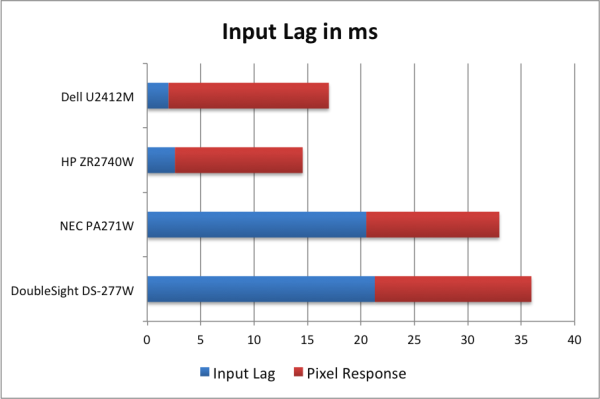DoubleSight DS-277W: Back to the Drawing Board
by Chris Heinonen on June 13, 2012 1:30 AM ESTSince all LCD displays have to be compared to a CRT display to calculate the lag, all of the testing is done at 1920x1080 resolution to keep the aspect ratio constant on the DS-277W. This might introduce a bit of an input delay, but because we use SMTT now to test displays we can separate input lag from pixel response to be more accurate.
Using SMTT, the DS-277W exhibited right around 21.3ms of input lag, and it took a full 29.3ms for a pixel to switch colors and come back, and combined this gives us an average response time of 36ms. This is over two frames of delay, so for many people this will not be an acceptable number for heavy gaming. Since the HP ZR2740w offers far faster pixel response time, and costs less to boot, that would be the 27” display I would still recommend with gaming in mind.

The DS-277W ships with an external power brick, and it seems to draw full current, all the time. At minimum brightness it was using 122 watts and at maximum it was drawing 125. Running at lower brightness to save on your energy bill isn’t a concern here, as the DS-277W is going to use a lot of power no matter how you have it setup.

I also tried to test out the DS-277W as a video display, since it has many inputs to use for this. Using an Oppo BDP-93 Blu-ray player, my first discovery was that in 1:1 mapping mode, it crops pixels from an HDMI signal. Losing 11 pixels on each side and 5 on the top and bottom, this is around 1% of overscan in effect, and there is really no reason for this at all. I did test using a PLUGE pattern from the Blu-ray player and found that the brightness control behaved the same over the HDMI input, controlling the black level as you’d expect on a TV.
Testing component didn’t even get that far. Once again using the Oppo player, which has a near perfect component video output, I couldn’t get an image on the screen at all. Using the Oppo BDP-83SE player instead also resulted in no image, so either the component video on my test LCD didn’t work correctly, or it didn’t like the timing of the Oppo players, or something else is just incorrect with the component video. Needless to say I wasn’t happy with the video testing results.











55 Comments
View All Comments
anishannayya - Wednesday, June 13, 2012 - link
Remember, this is 1440p we are talking about. I don't know many games that a single card card can push past 120 hz. At least games that would benefit from 120 hz (FPS).DarkUltra - Tuesday, June 19, 2012 - link
At high resolution you are limited by texture mapping and pixel shader performance. I turn off MSAA and set detail levels to high and Crysis 2 looks almost the same, but runs at 100-120 fps. Much easier to enjoy the action and everything looks more solid when I look around.http://jooh.no/index.php/2012/06/17/120hz-monitor-...
This is at 1920x1080 on a geforce gtx 580 and of course 120hz. If I manage to get a 1440p 120hz monitor I might need a gtx 680, it has twice as many texture mapping units. I wish 3D card reviews would test what gpu, cpu and settings you would need to get 120fps in games.
Every game I've tried benefits from 120hz/fps except old games that cannot render the graphics and mouse cursor faster than 30/60fps like Baldur's Gate and Diablo. Smoother, more precise mouse cursor and panning in RTS games also benefits greatly from 120hz/fps. Even games like C&C 3 that are locked at 30fps can since the cursor is rendered at its own layer updating at screen refresh.
DanNeely - Wednesday, June 13, 2012 - link
Displayport 1.2 has the bandwidth needed to do 2560x1600x120hz. I've seen reviewers report that 120hz was noticeably smoother when scrolling/moving the mouse on the windows desktop; so you should get some benefit from it even if you can't push the FPS that high while gaming.Anubis - Wednesday, June 13, 2012 - link
anand did a quick review of the QH270 lite - which is basically the same as the catleap (same panel just cant be overclocked)http://www.anandtech.com/show/5885/the-achieva-shi...
the 120 HZ capable monitors are not really made anymore and you are taking an even bigger gamble with the ones from 120hz IMO
however even without them doing 120HZ they are one of the best deals out there, you can get 2 for what 1 HP or Dell would cost
Cattykit - Wednesday, June 13, 2012 - link
http://brand.danawa.com/yamakasiAbove is the one that can be 'overclocked' to do 120hz.
For those who are interested in various IPS monitors, check the below Korean price search site. There, you'll see tons of IPS monitors with tons of different specs. and price point. It's quite amazing how cheap many of IPS monitors run: 27" 2560x1440 LED one being only $200.
http://www.danawa.com/product/list.html?defSite=DI...
anishannayya - Wednesday, June 13, 2012 - link
Rather useless, considering that the entire website is in Korean.alcortez - Wednesday, June 13, 2012 - link
All of those Korean monitors can be found on Ebay with 2 day shipping for ~$300-350.Snipe3000 - Wednesday, June 13, 2012 - link
Holy Bezels Batman!DBissett - Wednesday, June 13, 2012 - link
The title of the review suggests it's a pretty good monitor but not the best. The summary pretty much trashes the monitor and I was surprised. Just saying. The alternatives you suggested are good ones.JarredWalton - Wednesday, June 13, 2012 - link
True; I probably should have thought of that before posting for Chris. I've changed it now, as while the display *tries* to do a lot of things and be a "Jack of All Trades", the reality is it fails at pretty much everything it tries. A firmware update could work wonders, but sadly that hasn't happened despite being requested.